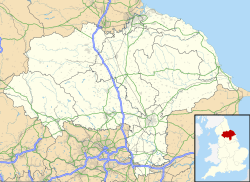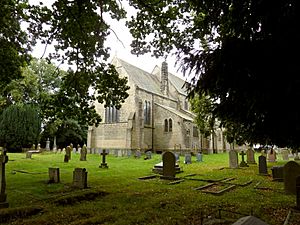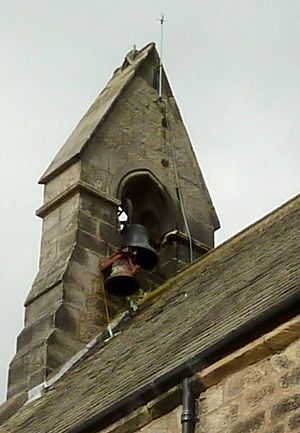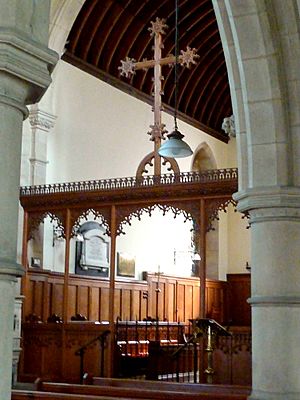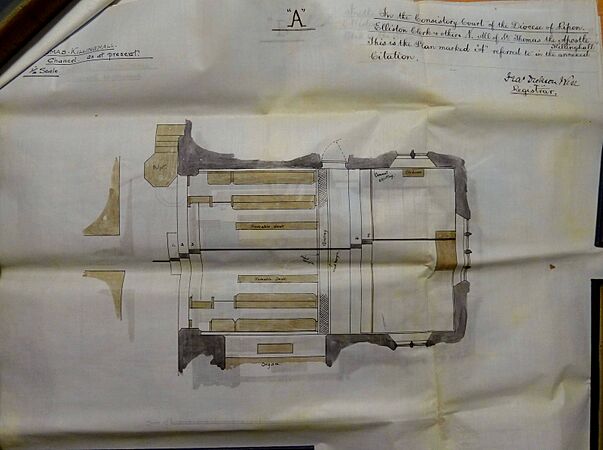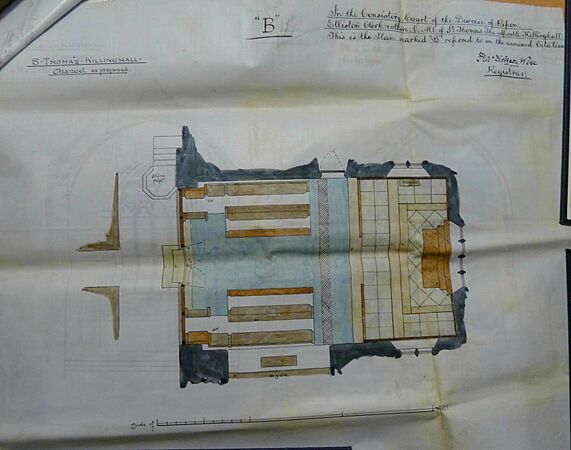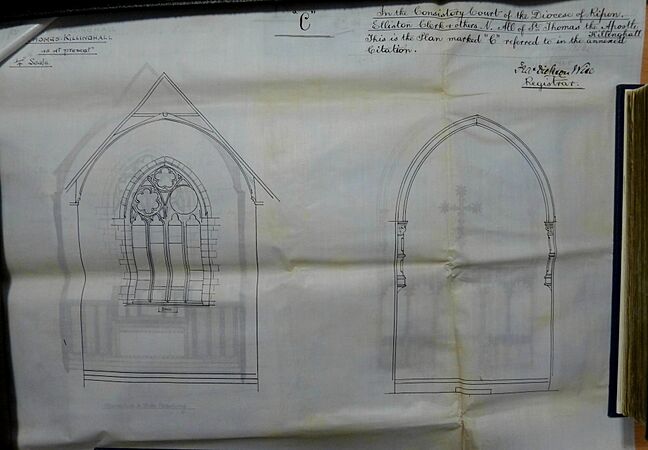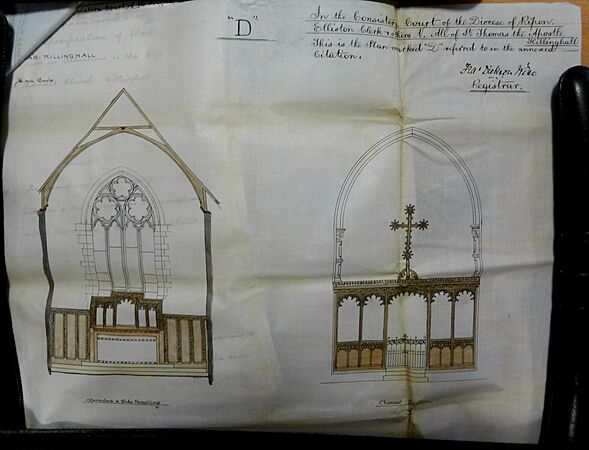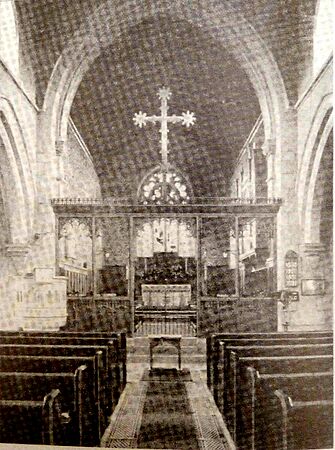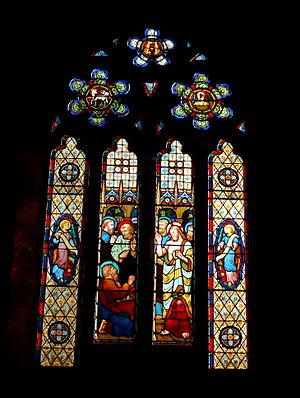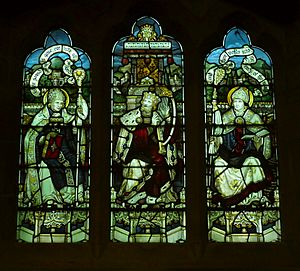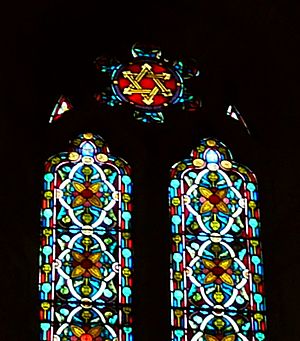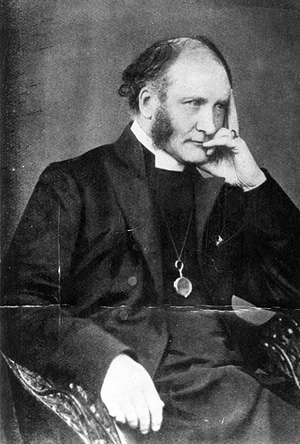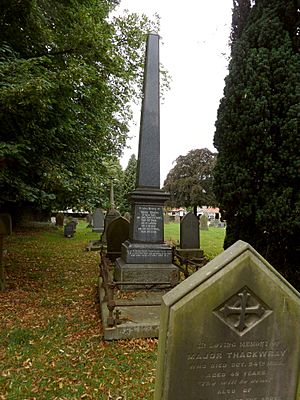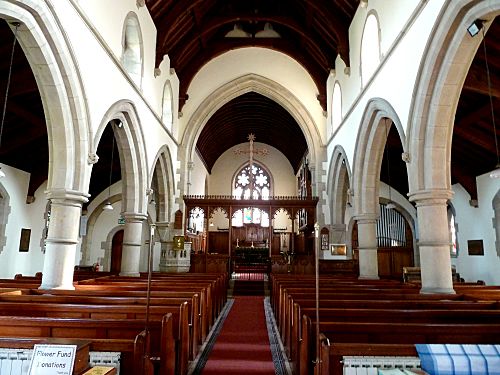Church of St Thomas the Apostle, Killinghall facts for kids
Quick facts for kids Church of St Thomas the Apostle, Killinghall |
|
|---|---|
| St Thomas the Apostle Parish Church | |
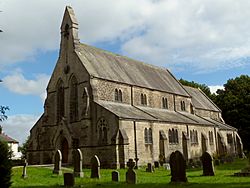
St Thomas the Apostle, 2016
|
|
| 54°1′18″N 1°33′59″W / 54.02167°N 1.56639°W | |
| OS grid reference | SE286584 |
| Location | Killinghall, North Yorkshire |
| Country | England |
| Denomination | Church of England |
| Churchmanship | Central |
| History | |
| Status | Parish church |
| Founded | 26 April 1879 |
| Dedication | Thomas the Apostle |
| Dedicated | 29 July 1880 |
| Consecrated | 29 July 1880 |
| Architecture | |
| Functional status | Active |
| Heritage designation | Unlisted |
| Architectural type | Parish church |
| Style | Gothic Revival architecture |
| Specifications | |
| Bells | 2 |
| Administration | |
| Parish | Ecclesiastical parish of Killinghall |
| Deanery | Harrogate (46503) |
| Archdeaconry | Richmond and Craven (465) |
| Diocese | Ripon and Leeds |
The Church of St Thomas the Apostle is a special Anglican church in Killinghall, North Yorkshire, England. It is a parish church, which means it serves the local community. The church was designed in 1879 by an architect named William Swinden Barber.
Before this church was built, Killinghall was part of the Ripley church area. But Killinghall was growing, and people needed a church closer to home. So, a new parish was created, and the Church of St Thomas the Apostle was opened in 1880. Some important early leaders of the church included Canon Sydney Robert Elliston and Canon Lindsay Shorland-Ball, as well as Robert Collier, who was a missionary.
Contents
Why the Church Was Built
Before the Church of St Thomas was built, people in Killinghall had to walk about 2 kilometers to the church in Ripley every Sunday. This was hard for older people or those who were not well. For a while, church services were held in the local schoolroom. However, everyone agreed that a proper church building would feel more sacred and special.
In the 1870s, Killinghall was getting bigger, with about 6,200 people by 1879. They really needed their own church. So, Killinghall became its own separate church area. Land for the church was given by Dr. and Mrs. Beaumont from Knaresborough. Many local landowners and friends also donated money to help build the church and a home for the vicar (the church leader).
The church committee received a large grant from the Church Commissioners. They planned to raise more money to build a church big enough for 400 to 500 people. They also planned to build a vicarage, which is the house where the vicar lives. To help raise money, a special event called a bazaar was held in August 1879. It was a big success, raising over £300. By July 1880, the church building cost more than £4,000, all raised through donations and fundraising events.
Building the Church
The first stone of the church, called the foundation stone, was laid on April 26, 1879. This important event was done by Sir Henry Day Ingilby from Ripley Castle, with about 300 people watching.
The church was designed in a style called Decorated Gothic, which was popular between 1290 and 1350. It is built from strong, cut stone blocks from a local quarry in Killinghall. The walls around the church, built in 1880, also use local stone. The front of the church, facing the road, has two windows with a special design called a Canterbury cross. The North Porch, which was once the main entrance, has a St Thomas Cross on top. Most other windows in the church have simple designs. The North Porch was later changed into a restroom around 2015.
The main builder, or mason, was James Simpson from Harrogate. He used stone from the Killinghall quarry for many local buildings, including the nearby Methodist Chapel. The woodworker was William Bellerby from York, and other skilled workers from nearby towns helped with the roof, plaster, plumbing, and painting. The total cost of the work and materials in 1880 was about £3,000.
Church Bells and Clock
The church has two bells. The larger bell was made in 1879 by Mears and Stainbank. It is still in its original place and can be rung with a bellrope. The smaller bell is connected to the church clock. This bell was made by John Taylor of Loughborough, probably in the 1930s when the clock was put in. It rings when the clock strikes the hour. Both bells have the maker's name on them. The clock and its bell were given to the church by the daughters of George Lewis, who was a churchwarden for 41 years.
Inside the Church
Inside the church, there are two rows of arches that separate the main area (the nave) from the side areas (the aisles). The floor of the chancel, which is the area near the altar, is three steps higher than the nave. The chancel has special seats for the choir and clergy, designed by the architect William Swinden Barber. The original choir seats were described as "plain but very solid."
On one side of the chancel is the organ room, and on the other side is the vestry, where the clergy prepare for services. All the wooden parts inside the church, like the roof and pews, are made of pitch pine. The church was designed to be very open and airy inside. At first, there was no organ, so a harmonium was used. The church still has a harmonium that might be from 1880.
The font (used for baptisms) and the pulpit (where sermons are given) were designed by the architect and made from Caen stone by Charles Mawer of Leeds. Lady Ingilby paid for them. Many other items in the church, like the communion plate, chairs, and altar, were donated by different people in the community. For example, Dinah Cautley paid for the beautiful oak chancel screen in 1905.
Church Organ
The pipe organ was built by William Andrews of Bradford and put into the church in 1908. It has a beautifully carved oak case. This organ was also donated by Dinah Cautley and was one of the largest in the Nidderdale area at the time. It was repaired in 1992.
Memorial Plaques
Inside the church, you can find several plaques that remember important people. There is a brass plaque for George Lewis, a churchwarden. Three other plaques remember members of the Strother family, including John Marmaduke Strother, who was a Second Lieutenant and died in action in 1917 at age 24 during World War I. He is also remembered on the Arras Memorial.
Dinah Cautley, who gave a lot of money to the church, also has a plaque. Another plaque remembers a judge named Frederick McCulloch Jowitt. There is also a tablet for Arthur Keightley Smith, the son of the church's first vicar, who was lost at sea during World War II. Canon Elliston, the second vicar, and the organist George Thomas Woods are also remembered with plaques.
1905–1908 Changes
Around 1905, some changes were made to the chancel area of the church. The vicar, Canon Elliston, and the churchwardens asked for permission to update the altar, choir stalls, and floor. They wanted to raise the chancel floor and put in new stone. They also planned a new, carved oak chancel screen with wrought iron gates. These gates were meant to keep strangers from entering the chancel when the church was open for private prayer.
The cost of these changes was estimated at £265, to be raised by donations. Dinah Cautley donated the money for the chancel screen. The original architect, William Swinden Barber, had retired, so another architect, C. Hodgson Fowler, designed these updates.
Stained Glass Windows
The church has many beautiful stained glass windows, each telling a story or remembering someone special.
South Aisle Windows
In the south aisle, one window shows Elizabeth and her son John the Baptist, along with the Madonna and Child. This window was given in memory of Amelia Tanner, the wife of Reverend Elliston. Another window shows a scene from the Bible where Jesus heals sick people. This was given by Dinah Cautley in 1887 to remember her husband, William, who was a doctor. A third window in this aisle shows the Annunciation (when an angel told Mary she would have Jesus) and the Resurrection (Jesus rising from the dead). This window was given by Dinah Cautley in memory of her mother.
Chancel Windows
On the north side of the chancel, one window shows two stories of Jesus bringing people back to life: the Raising of Lazarus and the Raising of the son of the widow of Nain. This window was given to William Strother by his mother. The large east window, made by Cox & Son, tells the story of Doubting Thomas from the Bible. It shows Thomas finally believing in Jesus's resurrection after seeing his wounds. The top part of this window has three small round windows with symbols: the Paschal Lamb, a pelican feeding its young (symbolizing sacrifice), and the Alpha and Omega (symbols for God). Thomas Strother paid for this window to honor his wife or mother. Another window in the chancel is dedicated to Thomas Strother (1806–1879) by his wife. It shows Saint Peter and Paul the Apostle.
North Aisle Windows
At the east end of the north aisle, a window shows Mary and Martha of Bethany. Mary is shown praying and reading, while Martha has items like a spinning wheel, showing her practical nature. This window was given by Ann Mitchell's husband to remember her. Another window in the north aisle has the theme of music and spreading the word of God. It shows King David playing music in the center. The side panels have words from Psalm 19 about God's message reaching all lands. The people on either side of David are saints. The dedication for this window is missing, but it was said to be given by William Clapham Cautley and dedicated to George Thomas Woods, who was the church organist for 24 years.
West Wall Windows
The windows on the west wall, at the end of the aisles, are similar. The stone design at the top of each window is a Canterbury cross with a stylized sunburst in colored glass. The main parts of these windows have clear glass, letting in lots of light, especially onto the font. The west window has two sets of two lights. The small round window on the right has the Star of David, and the one on the left has the IHS symbol, which stands for Jesus. This window was made by Cox and Son and paid for by Reverend T.C. Thompson.
Church Architect
William Swinden Barber (1832–1908) was an architect who specialized in designing Gothic Revival Anglican churches. He worked mostly in the areas of Brighouse and Halifax. He designed at least 16 buildings that are now Grade II listed, meaning they are historically important. Many of his church designs, including St Thomas the Apostle, were completed around 1880. Barber often designed the church fittings himself, like the pews, Caen stone pulpit, and font, and had local artists create them.
Church Consecration
The church was officially made sacred, or consecrated, by Robert Bickersteth, who was the Bishop of Ripon at the time. This happened on Thursday, July 29, 1880. It was a very important day for the village.
A local newspaper described how busy and lively the village was, with many carriages and people walking towards the new church. The church was completely full of people. Important guests included Sir Henry Day and Lady Ingilby from Ripley Castle, Lady Bickersteth (the Bishop's wife), and many people who had donated money to build the church. Local priests and a doctor were also there.
The Bishop was welcomed at the north porch by the church leaders, called wardens. Sir H.D. Ingilby presented the request for the church to be consecrated. Then, a procession of church leaders, the Bishop, and 23 other clergymen went to the chancel. The Killinghall choir sang, joined by singers from Ripley, and Fred Mitchell played the harmonium.
The Bishop gave a sermon, talking about how happy he was that the community now had a church nearby. He hoped that everyone would use the church often. Donations collected that day went towards paying off the remaining building costs and saving for the future vicarage. They collected £40. In the afternoon, there was a sale in the schoolroom, which raised more money for the building fund. This was followed by a tea party for 200 local people and an evening church service.
Centenary Celebrations
On Tuesday, July 29, 1980, a special service was held to celebrate the church's 100th birthday. This service was led by Reverend David Young, who was the Bishop of Ripon. After the service, Sir Thomas C.W. Ingilby cut a celebratory cake. At this centenary event, it was noted that the Church of St Thomas the Apostle had recorded 1,437 baptisms, 491 marriages, and 1,077 burials since it opened.
Church Graveyard
The church's burial ground was made sacred right after the church building was consecrated on July 29, 1880. The first burials happened in 1880, and people continued to be buried there at least until 1993. Dinah Cautley and her husband, who were big supporters of the church, have a noticeable grave here.
The Vicarage
The old vicarage, the house for the church's vicar, was built on Otley Road between 1880 and 1882. It might have been designed by William Swinden Barber, the church's architect. Fun events and garden parties used to take place in its gardens. The vicarage was sold in 1976 when the Killinghall parish joined with Hampsthwaite, meaning the vicar would live in Hampsthwaite.
Services and Activities
Church services usually happen on most Sundays at 9:30 AM at St Thomas the Apostle. However, on the fourth Sunday of each month, there is a combined service at 11 AM that rotates between Killinghall, Birstwith, Hampsthwaite, and Felliscliffe churches. The church uses the Book of Common Prayer for its services.
There is a Sunday school in the village hall on the first Sunday of every month. Holy Communion services are held on the first and second Sundays, and an "all age worship" service is on the third Sunday. During school term time, there's tea and toast on Tuesday mornings, followed by prayers. On the second Tuesday of the month, there's a "mums and tots" session and a coffee and cake session for everyone in the afternoon. The church has a regular choir and hosts live music concerts. You can also hire the church for concerts and other events.
The church building is wheelchair-accessible and has toilets, baby-changing facilities, and an Audio induction loop for people with hearing aids. They also have large-print hymn books, and guide dogs are welcome. A crèche (childcare) is sometimes offered.
Church Leaders (Vicars)
Over the years, many vicars have served the Church of St Thomas the Apostle.
Killinghall Parish Vicars
- Reverend Reginald Keightley Smith (1880–1903): He was the first vicar of Killinghall, starting when the church was consecrated in 1880. He served until his death in 1904. He donated the lectern (a stand for reading) to the church.
- Canon Sydney Robert Elliston (1904–1935): He was the second vicar and served during difficult times like the Great War and the Great Depression. He was also important in the financial work of the Ripon Diocese.
- Reverend Alfred William Price (1936–1940): He was one of two vicars who served during World War II. He was known for his good humor.
- Canon Lindsay Shorland-Ball (1940–1947): He also served during World War II and was a naval chaplain. He noted that church attendance had decreased during the war.
- Venerable Robert Collier (1948–1952): He had a background as a missionary in Kenya and India before becoming vicar of Killinghall.
- Reverend Andrew Hodgson (1952–1958): He was also a chaplain for the army reserves.
- Reverend Robert V. Morris (1958–1976): During his time, the church choir was very good and even sang at Ripon Cathedral. He retired in 1975.
Hampsthwaite and Killinghall Parish Vicars
From 1976, the Killinghall parish joined with Hampsthwaite, meaning one priest would serve both. In 1993, the two areas were officially combined.
- Reverend John Frederick Walker (1976–1986): He was the priest in charge of Hampsthwaite and Killinghall. He wrote a pamphlet for the church's 100th birthday in 1980.
- Reverend Anthony George Hudson (1987–1999): He was priest in charge of both parishes. He also worked for the Ripon and Leeds Diocesan Board of Finance.
- Reverend Garry Anthony Frank Hinchcliffe (2000–2013): He served as vicar for Hampsthwaite and Killinghall, and later also Birstwith. He moved to Knaresborough in 2013.
- Reverend Christella Helen Wilson (2014–present): She became the vicar of St Thomas, Hampsthwaite (which includes Killinghall and Birstwith) in 2014. She was ordained as a priest in 2012.


